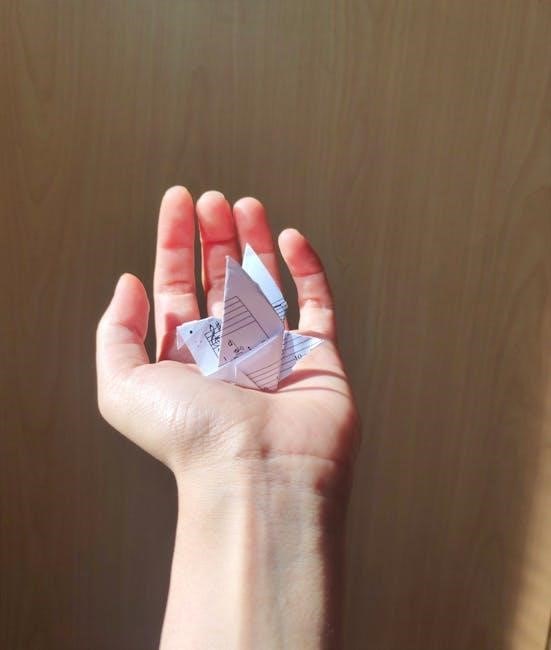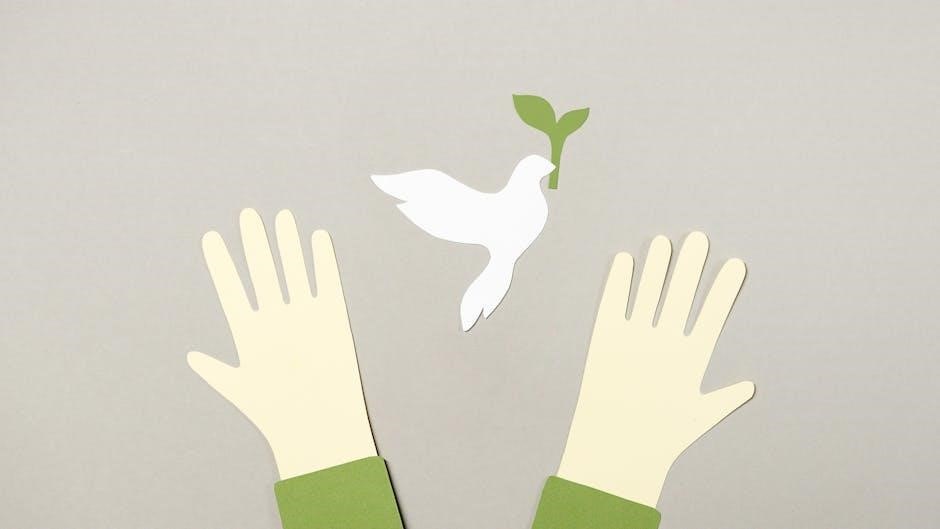Easy Origami Dragon Instructions PDF: A Comprehensive Guide

This comprehensive guide offers detailed origami dragon instructions for enthusiasts of all levels. Perfect for beginners‚ it provides step-by-step folding techniques to create a majestic paper dragon. Download the PDF now!
Origami‚ the ancient Japanese art of paper folding‚ has captivated creators worldwide with its blend of simplicity and intricate designs. Among its many models‚ the dragon stands out as a symbol of power‚ good fortune‚ and mythical allure. This majestic creature‚ deeply rooted in Asian cultures‚ has become a favorite among origami enthusiasts. Its popularity stems from its versatility‚ allowing for both simple and complex designs‚ making it accessible to beginners and challenging for experts. The availability of easy origami dragon instructions in PDF formats has further fueled its appeal‚ enabling anyone to bring this mythical creature to life. Whether you’re crafting a traditional dragon or a modern variation‚ origami offers a creative journey that combines art‚ precision‚ and cultural heritage.

Materials and Tools Required for Folding an Origami Dragon
To create an origami dragon‚ you’ll need square paper (20cm x 20cm recommended)‚ a bone folder or similar tool‚ and optional items like scissors or a spray bottle for wet-folding techniques.
Types of Paper Suitable for Origami Dragons
For crafting an origami dragon‚ choosing the right paper is essential. Tissue-foil is highly recommended for its vibrant colors and durability‚ while Elephant Hide and Lizard Hide papers offer a leathery texture ideal for wet-folding techniques; Biogami is another excellent option‚ known for its eco-friendliness and pliability. Standard origami paper or even copy paper can also be used‚ though they may lack the premium finish of specialized papers. For a more delicate look‚ single-sided paper is a great choice. Wet-folding works best with papers that can absorb moisture without tearing‚ allowing for sharper folds and a more defined shape. These options ensure your dragon will be both visually stunning and long-lasting.
Recommended Paper Sizes and Colors
When selecting paper for your origami dragon‚ size and color play a crucial role. A 20cm x 20cm square is ideal for detailed folds‚ while a 15cm x 15cm sheet is perfect for smaller‚ more manageable designs. For a vibrant look‚ opt for red or multi-colored tissue-foil‚ which adds a striking finish. Neutral tones like white or beige are great for a classic‚ minimalist appearance. Single-sided colored papers ensure a clean‚ professional look‚ while patterned papers can add unique character. Avoid overly thick or thin papers‚ as they may not hold folds well. Choosing the right size and color enhances both the folding experience and the final result of your origami dragon.
The Importance of Wet-Folding Techniques
Wet-folding is a game-changer for creating intricate origami dragon models. This method involves lightly dampening the paper to make it more pliable‚ allowing for smoother folds and sharper creases. It is particularly effective for papers like Elephant Hide‚ Lizard Hide‚ and Biogami‚ which are ideal for detailed designs. Wet-folding reduces the risk of tears and cracks‚ ensuring your dragon’s wings‚ tail‚ and head retain their shape. While optional‚ this technique enhances precision and durability‚ making it a must-try for achieving professional-looking results. By incorporating wet-folding‚ you can bring out the full majesty of your origami dragon‚ creating a piece that is both visually stunning and long-lasting.

Step-by-Step Instructions for Folding an Easy Origami Dragon
Begin by folding the paper in half diagonally to create a sharp crease. Next‚ fold it again to form a triangle. Create initial creases for the body‚ then shape the head‚ wings‚ and tail step by step.
Folding the Paper in Half Diagonally
Start with a square sheet of paper and fold it in half diagonally to create a sharp crease. Repeat this process on the other diagonal to form an “X” crease. These creases will serve as a guide for subsequent folds. Ensure the edges align perfectly for a crisp fold. Gently press the paper to create a visible line. This step establishes the foundation for the dragon’s body and head structure. For accuracy‚ use a bone folder or similar tool to sharpen the creases. Once done‚ unfold the paper to reveal the creases‚ which will help in forming the dragon’s shape later. This initial fold is crucial for maintaining symmetry and balance in your origami dragon design.
Creating the Initial Creases and Folds
After folding the paper in half diagonally‚ open it and fold it in half horizontally and vertically to create additional creases. These creases will guide you in forming the dragon’s body and tail. Next‚ fold the top three corners down to the bottom corner‚ ensuring the edges align neatly. This step helps shape the dragon’s head and neck. Gently press each fold to create sharp creases. For precision‚ use a bone folder or similar tool to reinforce the folds. These initial creases and folds are essential for maintaining symmetry and balance in your origami dragon. By carefully following these steps‚ you’ll establish a solid foundation for the detailed folds that follow. Remember‚ patience and precision are key to achieving a professional-looking result. These creases will later help in forming the wings‚ legs‚ and other intricate details of the dragon. Take your time to ensure each fold is crisp and accurate.
Forming the Body and Tail of the Dragon
Once the initial creases are in place‚ fold the paper in half vertically to form the dragon’s body. Open it slightly and fold the bottom half upward‚ creating a layered effect for the tail. Ensure the edges align neatly to maintain symmetry. Next‚ fold the top portion downward to meet the base‚ forming the neck. Use valley folds to shape the body‚ ensuring a smooth transition between folds. The tail should be narrow and taper gently. Gently press each fold to secure it in place. Avoid applying too much pressure‚ as this could cause the paper to tear. Use the pre-made creases as guides to ensure accuracy. For a more lifelike appearance‚ slightly curve the tail and body. This step requires patience and careful alignment to achieve a balanced‚ natural-looking dragon shape. Take your time to refine the folds for a polished result;
Shaping the Head and Horns
To shape the dragon’s head‚ fold the top portion of the paper downward‚ creating a small triangle that forms the muzzle. Use a mountain fold to create a slight indentation at the base of the head for a natural curve. For the horns‚ take the top layer of the paper and fold it backward‚ forming two small triangles. Secure these horns by tucking the edges under the head. Gently pull the horns outward to ensure they are evenly spaced and upright. Use a small valley fold at the tip of the muzzle to create a subtle nose. Finally‚ round the edges of the head slightly for a softer appearance. Ensure the horns are proportional to the head and adjust as needed for balance. This step brings the dragon to life‚ giving it a fierce yet elegant look.
Creating the Wings and Legs
To create the wings‚ fold the sides of the dragon’s body outward‚ forming triangular shapes. Lift the top layer of each side and fold it downward‚ securing with a small mountain fold at the base. Adjust the angle of the wings to achieve a natural‚ spread appearance. For the legs‚ fold small flaps from the bottom of the body‚ shaping them gently downward. Each flap should be folded symmetrically to ensure balance. Use a valley fold to define the knee joints‚ giving the legs a slight bend. Ensure the wings and legs are proportional to the dragon’s body for a balanced look. Adjust the edges smoothly to maintain a seamless appearance. This step adds movement and stability to your origami dragon‚ bringing it closer to completion.
Final Adjustments and Details
Once the main structure of the dragon is complete‚ focus on refining its appearance. Gently pull out any uneven edges and ensure symmetry in the wings and legs. Use a bone folder or similar tool to sharpen creases for crisp folds. Lightly shape the dragon’s head and tail to enhance its natural curve. For a more realistic look‚ add small details like eyes using a marker or a pinpoint fold. If desired‚ use the wet-folding technique to smooth out the scales or texture for a softer‚ more lifelike finish. Patience is key during this step‚ as precise adjustments elevate the dragon’s overall aesthetic. Take your time to perfect every fold‚ and your origami dragon will stand out as a masterpiece of precision and artistry.

Tips and Tricks for Successful Origami Dragon Folding
Use reference images for accuracy and patience for precise folds. Employ basic origami techniques like valley and mountain folds. Utilize tools like bone folders for sharp creases and smooth edges.
Using Reference Images for Accuracy
Reference images are invaluable for ensuring accuracy when folding an origami dragon. They provide visual guidance‚ helping you understand complex steps and maintain the model’s symmetry. Many tutorials‚ such as Jo Nakashima’s origami dragon instructions‚ include diagrams or photos to illustrate each fold. By comparing your work to these images‚ you can identify and correct mistakes early‚ saving time and frustration. Additionally‚ video tutorials offer real-time demonstrations‚ making it easier to follow intricate movements. For beginners‚ reference images are especially helpful in mastering basic folds like valley and mountain creases. They also highlight key details‚ such as wing shapes or tail proportions‚ ensuring your dragon looks authentic. Downloading PDF guides with step-by-step visuals can further enhance your folding experience. Use these resources to achieve precision and confidence in your origami dragon creation.
Understanding Basic Origami Folds
Mastering basic origami folds is essential for successfully creating a dragon model. Fundamental techniques like valley folds‚ mountain folds‚ and squash folds form the foundation of most designs. A valley fold involves folding paper downward‚ while a mountain fold creates an upward crease. Squash folds shape layers into flat surfaces‚ crucial for details like wings or legs. These folds are often combined to create more complex shapes‚ such as the bird or frog base‚ which are common starting points for dragons. Practicing these basics ensures precision and symmetry in your final model. Many tutorials‚ including Jo Nakashima’s designs‚ rely on these foundational techniques. By understanding and perfecting these folds‚ you’ll build a solid skill set for crafting intricate origami creations‚ including the majestic dragon. Start with simple exercises to gain confidence before tackling more advanced steps.

Maintaining Patience and Precision
Maintaining patience and precision is crucial when folding an origami dragon. Rushing through steps can lead to misaligned folds and a less polished final result. Take your time to carefully follow each instruction‚ ensuring accuracy in every crease and fold. Even simple designs require attention to detail to achieve the desired shape. For beginners‚ it’s especially important to embrace the process and not get discouraged by initial mistakes. Precision ensures that the dragon’s features‚ such as wings‚ legs‚ and horns‚ turn out defined and symmetrical. Practice each fold step-by-step‚ and remember that patience is key to mastering the art of origami. Celebrate small victories along the way‚ as each completed fold brings you closer to your majestic dragon creation.
Using the Right Tools for Folding
Using the right tools for folding is essential for achieving the best results in origami dragon creation. A bone folder or similar blunt tool can help create sharp‚ crisp creases‚ making folds more precise and easier to handle. Tweezers or small clamps are useful for reaching tight spaces‚ especially when shaping intricate details like horns or wings. A flat surface‚ such as a table or cutting mat‚ provides stability while folding. While scissors are rarely needed for traditional origami‚ they can be handy for trimming paper to the desired size. Additionally‚ a ruler can help measure and align folds accurately. For wet-folding techniques‚ a damp cloth or sponge is necessary to soften the paper. Using these tools will enhance your folding experience and ensure your dragon turns out as intended.

Common Variations of the Origami Dragon
Explore variations like the Chibi Dragon‚ a simplified version with minimal details‚ and the Dragon Bookmark‚ a compact design. Advanced versions include the intricate Devil Dragon for skilled folders.
The Chibi Dragon: A Simplified Version
The Chibi Dragon is a charming‚ simplified version of the origami dragon‚ designed for beginners or those seeking a quicker project. It features a basic head without horns and minimal detailing on the wings and legs. This model is part of the evolutionary process leading to more complex designs‚ making it an excellent intermediary step for learners. The Chibi Dragon uses standard origami paper‚ such as 15cm x 15cm squares‚ and can be completed in about 30-45 minutes‚ depending on prior experience. Wet-folding techniques are recommended for smoother folds‚ especially with textured papers like Elephant Hide or Biogami. This compact dragon is perfect for those who want to enjoy the essence of origami without intricate details‚ offering a delightful introduction to dragon folding. Its simplicity makes it a great starting point before advancing to more complex versions like the Devil Dragon.

Dragon Bookmark: A Compact Design
The Dragon Bookmark offers a unique twist on traditional origami dragons‚ blending functionality with artistry. This compact design allows the dragon to serve as a practical bookmark‚ making it a delightful and useful creation. Perfect for origami enthusiasts who enjoy combining creativity with everyday items‚ the Dragon Bookmark is surprisingly easy to fold. It follows similar steps to the standard dragon but is scaled down to fit neatly between book pages. The design retains key dragon features‚ such as a stylized head and tail‚ while maintaining a slim profile. Instructions for this model are often included in origami dragon PDF guides‚ providing clear step-by-step directions for crafting this charming and functional piece; Its small size makes it an excellent project for those with limited time or materials‚ ensuring that even beginners can enjoy the satisfaction of creating their own bookmark dragon.
Advanced Versions: Devil Dragon and Beyond
For experienced origami enthusiasts‚ the Devil Dragon and other advanced versions offer a thrilling challenge. These intricate designs push the boundaries of paper folding‚ featuring complex details like scaled textures‚ wing patterns‚ and dramatic poses. The Devil Dragon‚ in particular‚ is renowned for its striking appearance and intricate folding techniques‚ requiring mastery of advanced folds such as wet-folding and sink folds. These models are perfect for those seeking to elevate their skills and explore the art of origami beyond basic designs. While they demand more time and precision‚ the result is a breathtakingly detailed dragon that showcases artistic mastery. Advanced versions like these are often included in specialized origami dragon PDF guides and tutorials‚ catering to seasoned folders who crave complexity and creativity in their projects.

Additional Resources for Origami Enthusiasts
Discover a wealth of resources‚ including PDF guides‚ tutorial videos‚ and online communities. These tools help beginners and experienced folders master the art of origami dragon folding with ease and precision.

Downloading PDF Instructions
Downloading PDF instructions for an easy origami dragon is a convenient way to access step-by-step guides. Many websites offer free or premium downloadable PDFs designed for enthusiasts of all skill levels. These guides often include detailed diagrams‚ written instructions‚ and visual aids to ensure accuracy. Popular creators like Jo Nakashima provide PDF tutorials that break down complex folds into manageable steps. Additionally‚ platforms like Amulrev and Origami.me offer downloadable resources‚ including paper size recommendations and tips for materials like tissue foil or standard origami paper. Some PDFs even cater to specific variations‚ such as the Chibi Dragon or Dragon Bookmark. Downloading these resources allows you to learn at your own pace and refer back to instructions as needed. They are ideal for both beginners and experienced folders looking to refine their techniques or explore new designs.
Watching Tutorial Videos
Watching tutorial videos is an excellent way to master the art of folding an easy origami dragon. Videos provide visual guidance‚ making it easier to follow complex folds and understand the sequence of steps. Many creators‚ such as Jo Nakashima‚ offer detailed YouTube tutorials that demonstrate each fold in real time. These videos often include close-ups‚ slow-motion replays‚ and verbal explanations‚ ensuring clarity for learners of all skill levels. Platforms like YouTube and Origami.me host playlists dedicated to origami dragons‚ featuring variations like the Chibi Dragon and Dragon Bookmark. Additionally‚ some videos focus on specific techniques‚ such as wet-folding or shaping wings‚ to help enthusiasts refine their craft. Tutorial videos are particularly helpful for visual learners‚ as they allow for pausing‚ rewinding‚ and practicing alongside the instructor. This hands-on approach makes learning fun and accessible‚ even for those new to origami.
Joining Origami Communities
Joining origami communities is a fantastic way to connect with fellow enthusiasts‚ share ideas‚ and learn new techniques for creating an easy origami dragon. Online forums‚ social media groups‚ and specialized websites like Origami.me offer platforms to discuss folding methods‚ showcase creations‚ and gain feedback. Many communities host challenges‚ tutorials‚ and events to inspire creativity. For example‚ Jo Nakashima’s origami group on Facebook is a hub for dragon enthusiasts‚ featuring tips and step-by-step guides. Additionally‚ websites like Mathigon and Origami-Shop provide resources and forums for beginners and advanced folders alike. Engaging with these communities fosters a sense of belonging and motivation‚ helping you refine your skills and explore variations like the Chibi Dragon or Dragon Bookmark. Whether you’re a novice or an expert‚ origami communities are a treasure trove of inspiration and knowledge.
Embrace the joy of creating an origami dragon with our easy-to-follow guide. This craft offers a fulfilling journey of patience‚ creativity‚ and precision. With each fold‚ you’ll unlock the magic of this mythical creature‚ inspired by the step-by-step PDF instructions and tips from experts like Jo Nakashima. Whether you’re a beginner or an experienced folder‚ this art form promises endless satisfaction and inspiration. Dive into the world of origami‚ and let your dragon soar!
Final Thoughts on the Creative Process
Creating an origami dragon is a rewarding journey that combines artistry and precision. Jo Nakashima’s designs simplify the process‚ making it accessible for all skill levels. Using techniques like wet-folding and starting with a basic bird or frog base ensures a strong foundation. The transformation from a simple square paper to a majestic dragon is truly magical. Each fold tells a story‚ and the patience invested results in a stunning‚ personalized creation. Embrace the process‚ explore variations like the Chibi Dragon‚ and enjoy the satisfaction of bringing this mythical creature to life with every carefully crafted fold.

